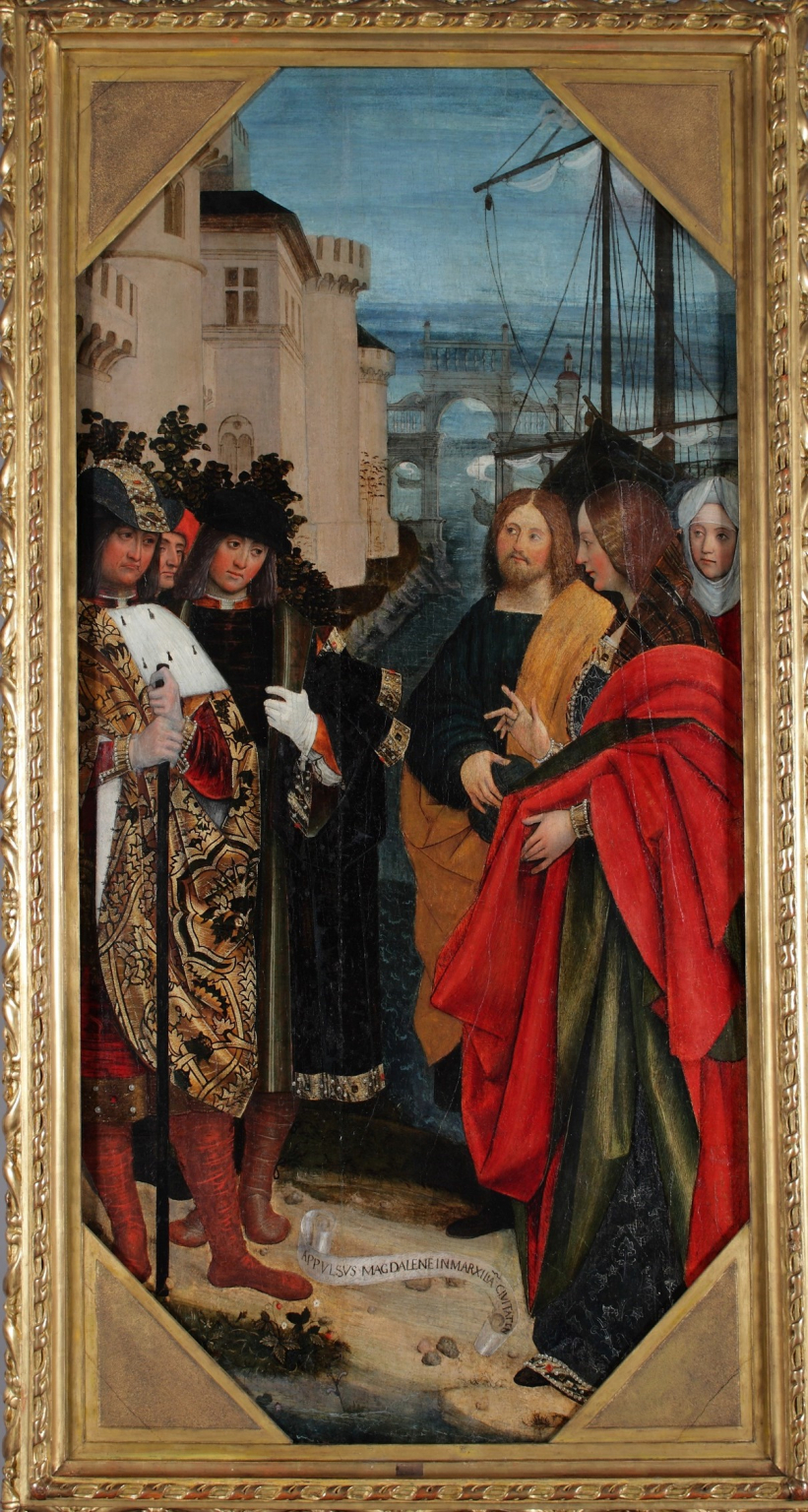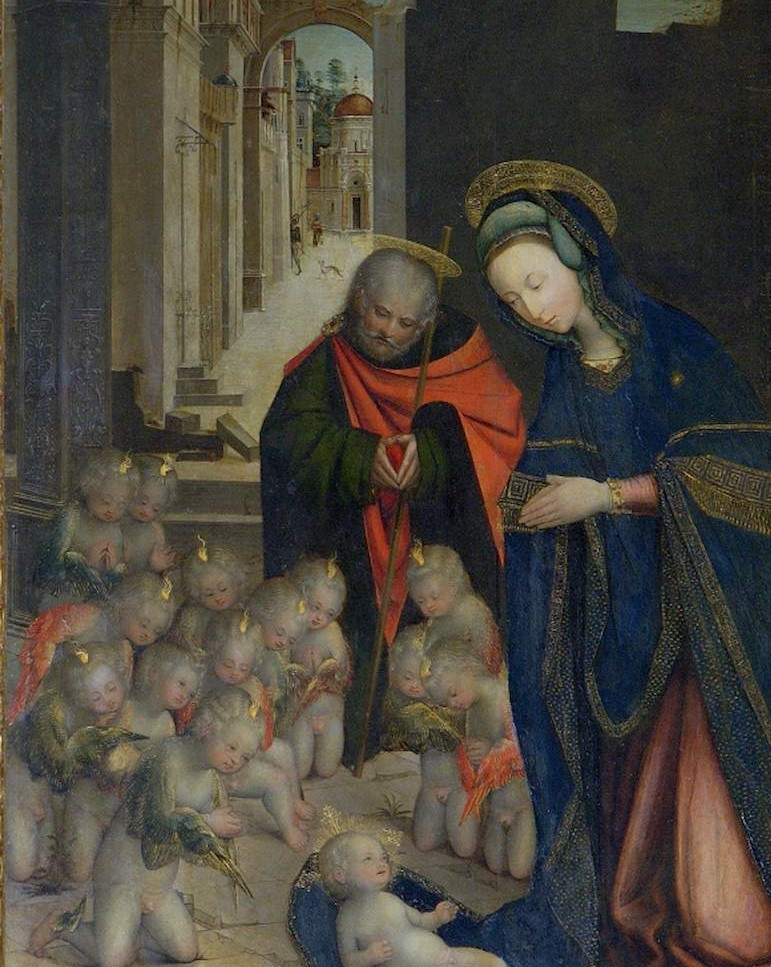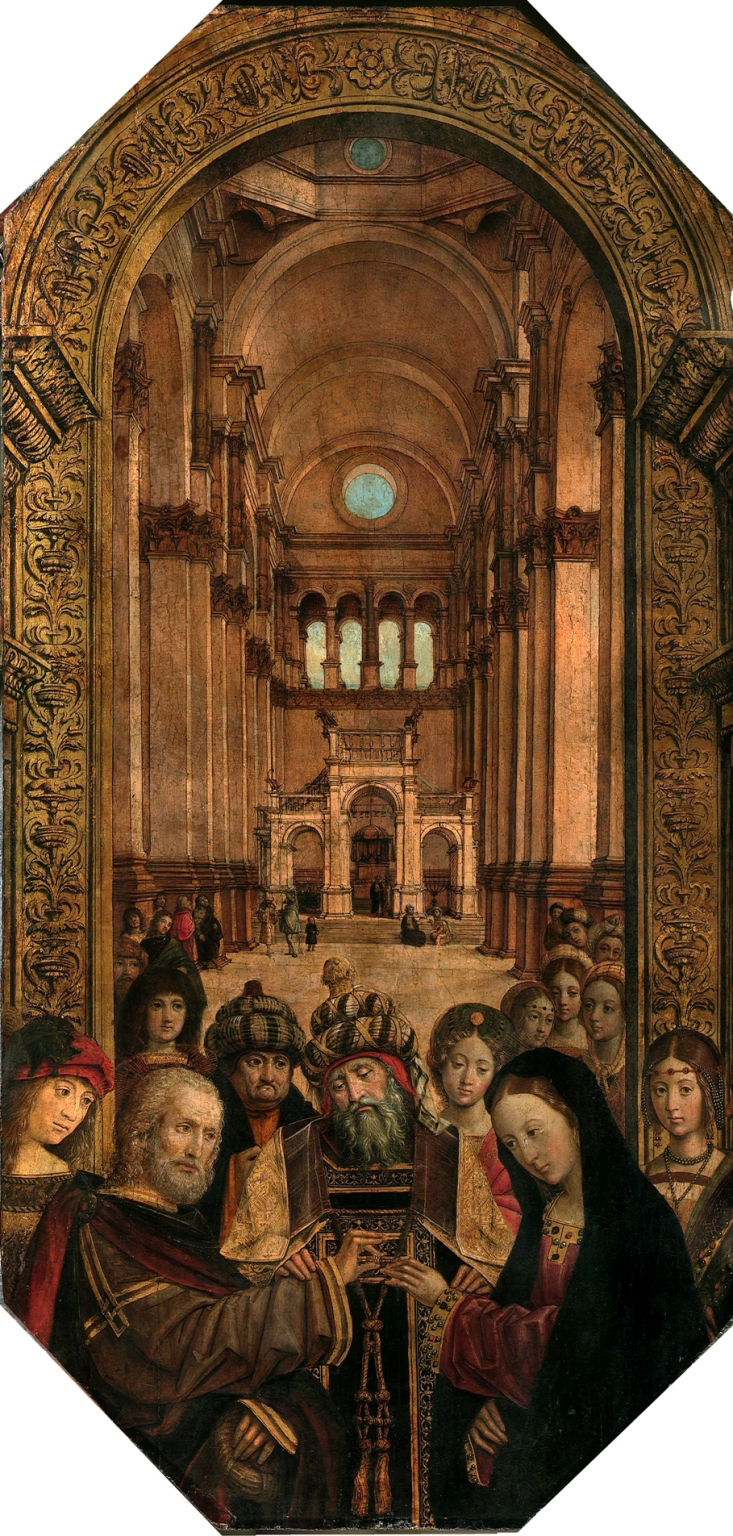Defendente Ferrari: escape from the Renaissance
Defendente Ferrari keenly sought refuge in dreams during an era that instead celebrated the triumph of reality.
In the apse of the church of Sant’Antonio di Ranverso, called the Precettorìa degli Antoniani, one can admire the great Polittico della Natività painted in approx 1532 by Defendente Ferrari. The church is in the lower Susa valley, where the large religious complex founded in 1188 welcomed pilgrims on the ancient Francigena route, a busy path between northern and southern Europe for several centuries. The canonical order of St. Anthony of Vienne provided assistance to sick pilgrims – the monks were specialists in the treatment of herpes zoster (the fire of St Anthony in Italian) and ergot infection. The pig fat was the secret to their effective cure. According to a medieval vulgate, Saint Anthony the Abbot had miraculously ascended to heaven in the company of his favorite pet animal: a pig.
In the great altarpiece created in Ranverso by Defendente Ferrari, the figure of the saint emerges in the lateral compartment of the polyptych in a quilt of gold; he holds a stick in his left hand and a bell in his right. At his feet is a black pig and the flickering, stylized flame, a symbol of the pains caused by herpes. Seven stories from the saint’s life are represented on the dais. Here, Defendente’s brush moved as though it were touched by a clear breath of alpine snow, imbued with naturalistic precision of Flemish inspiration.

The fusion of Gothic elegance and Flemish painterly aspects is remarkable in the oeuvre of Defendente. These features emerge in the landscapes of the predella, especially in the characters and in the glimpses of everyday life such as the flask that hangs from a beam in the stable of the Nativity or Adoration (1511) of the church of San Giovanni in Avigliana near Turin. On the other hand, there is no shortage of colored marble inlays and architectures built with perfect geometrical perspective typical of Tuscan Renaissance – see the central nativity scene in the Ranverso polyptych, or in the Triptych of the Nativity, Adoration of the Magi and Deposition of Christ (1523) in the Galleria Sabauda in Turin. The latter is set in a ruinous architecture, composed of ancient elements typical of Piedmontese Renaissance buildings. Next to the collapsed capitals, indices of the fall of the ancient world, seemingly made of a poor and therefore more human material, there is the child lying on a hem of the maternal mantle of a deep night blue, edged with moss green. The new world walks in the darkness of nature until it reaches the light above a stable.
In the Triptych of the Nativity, Adoration of the Magi and Deposition of Christ, humanity and humanism are fused, but do not conform to that model of the “preordained loggias and rooms between the Tiber and Arno” as Giovanni Testori wrote in his work La Realtà della Pittura, which is responsible for the rediscovery of ancient painters from northern Italy – those of the “Gran teatro montano,” as he titled one of his memorable essays. The name of Defendente Ferrari, who was a stranger to the Tuscany and Rome-oriented mainstream Italian Renaissance history, disappeared for centuries. Furthermore, after the suppression of religious orders at the end of the 18th century, many of his polyptychs were dismantled and dispersed in various museums in Italy, Europe and the US.
Simone Baiocco, a curator at Palazzo Madama in Turin and scholar of the artist, stresses the centrality of the Ranverso polyptych to understand the work of Defendente Ferrari, not only because this painting is exceptionally preserved in its overall structure, including the case and the two large doors that close it – a typology of Nordic origin. It is also because of recent attribution history. In the 1860s, the Barnabite priest Luigi Bruzza found the contract for the construction of the polyptych of the nativity, commissioned to a certain “Deffendente de Ferrariis de Clavaxio (Chivasso) pinctore”, in the municipal archive of Moncalieri. Thanks to this discovery, which brings the name of Defendente to light for the first time in relation to the painting, scholars would again browse the archives of the Municipality of Chivasso to find traces of the artist’s activity. His paintings were previously attributed to other artists, sometimes high-sounding names such as Albrecht Dürer for example. From the discovery of Bruzza, through comparisons and research of homogeneous stylistic traits, many paintings scattered in various churches of Piedmont or held in museums and private collections found a new author.

Information about the life of Defendente is still uncertain and fragmentary. He was probably born between 1480 and 1485 in Chivasso to Giovanni Francesco, a goldsmith who died around 1540 in Turin. The artist trained in the workshop of Gian Martino Spanzotti, an artist who particularly influenced the style found in a large area from Vercelli to Casale and Turin. The close collaboration with Spanzotti is reflected in a confluence of traits, which caused problems of attribution between the works of the master and the first pieces of his pupil Defendente. The exhibition Il Gotico e Rinascimento in Piemonte, curated by Vittorio Viale in 1938, focused on this exchange. Subsequently though, the master was more accurately set apart from his student by scholars, thanks to the latter’s more insistent delicacy of the drawing, his very elegant decorations joined with candid narrations (so much so that Bernard Berenson will dub him a “Piedmontese Crivelli”), the love for fiery colors such as enamelled green, blue, gold and especially red.

There are still no overarching analyses of the art of Defendente Ferrari. However, there are many in-depth studies on individual polyptychs or paintings, developed especially on the occasion of the restorations, such as the one on the Bianzè Polyptych at the Borgogna Museum in Vercelli, curated by Cinzia Lacchia and Massimiliano Caldera in 2015; or the studies also by Caldera and Paola Manchinu curated by Maria Cristina Rodeschini in 2009 for the exhibition on the restoration of the Flagellation of Christ and Christ in Meditation Seated on the Cross, two works from approx 1520, now held at the Carrara Academy in Bergamo. Together they formed the doors of a Crucifixion, now in Palazzo Madama in Turin.
The subject of Christ in meditation was rarer in Italy than in northern Europe. The son of God, already naked, wrapped only in a loincloth, sits on his own cross, emblem of martyrdom, waiting for a henchman with an awl and nails to finish the work. Christ has his head dripping with blood, reclined and resting on his hand; his mouth is slightly open, his pearly teeth glisten; his gaze is absorbed upwards, assuming a posture that refers to the enigmatic figure of one of the most famous Renaissance engravings, namely Melancholia by Albrecht Dürer (1514). Certainly the melancholic pose, this “human thoughtfulness” as Aby Warburg defines it, has a long classical tradition; but it is surprising that Defendente takes it up again in the same period in which Dürer is rethinking and giving a strong humanistic value to this ancient iconographic formula.

Important studies of a few Defendente paintings are also lacking, for example the Adorazione del bambino a lume di notte at Palazzo Madama, which acquired it along with the rest of Leone Fontana’s collection in 1909. The prominent scholar Simone Baiocco stressed the importance of this collection – a series of 35 works – in an essay for the centenary of the donation. The subject of Piedmontese Primitives and Piedmontese pictorial Renaissance has been one of the museum’s interests ever since.
The Adorazione is a small panel, dated 1510 hence among Defendente’s early efforts. The work is a very human interpretation of the Christmas night and one of the first nightly subjects in Italian painting. The child is on the nock of Mary’s cloak, under the warm breath of the ox and the donkey; a few highlights on its dark mantle are enough to turn it into a starry sky; the flame of the candle held by Joseph beats on his broad face (of Spanzottian origin) as to induce him with a spontaneous gesture to raise his hand to protect himself; behind him, a shepherdess smiles at the enchantment of birth. The picture presents a detailed and poetic execution. Also in 1511 (but later dates between 1518 and 1520 are also proposed), Defendente painted another Nativity – Natività con i Santi Innocenti – for the Certosa di S. Maria in Banda, a remote mountain village. The work is linked by stylistic consonances to the Nativity in the church of San Giovanni di Avigliana (Turin) and the one today in the Bode Museum in Berlin. The painting is now in the Cathedral of San Giusto in Susa.

In the Nativity painted for the Certosa di S. Maria in Banda, in a dilapidated architecture between dream and reality, there are no little shepherds in adoration of the child. According to an unusual and rare iconography, the Holy Innocents surround the newborn. They all share diaphanous flesh and blond curls; their gold or pink, cherub-like wings are tangled in prayer; their sex is exposed to remember how they perished in the massacre ordered by Herod. The flowers on the proscenium, especially the violets, symbolise humility; the tricolor ones allude to the Trinity; the white Silene, or flower of the tomb prefigures the destiny of Christ. It is in a flowery garden, in full neo-gothic and neo-courteous spirit that painting flourishes by the hand of Defendente and his workshop, which was increasingly larger until the 1540s. In an essay on Spanzotti, Testori says of Defendente that he is “hilarious like a well-trained nightingale” and adds that “under his melody you never hear the deep bass sound, the murmur that continues to flow like a river coming down from the Alps.” Close to Defendente there are Giovenone, Gandolfino and the circle of anonymous artists who preside over the Alpine areas of Piedmont. Bernard Berenson also expressed a contradictory opinion on Defendente: “the fourth rank might be too high for him, for he has none of the qualities essential to the figurative arts.”
The critic, whose judgment became rule, speaks of a fourth-rank artist, but of great charm, so much so that he recommended to one of his great American clients the purchase of a work by Defendente: the altarpiece Madonna in trono e quattro santi, now in the G. Johnson collection in Philadelphia. It is the adjective “pleasant” that returns to Berenson in his North Italian Painters of the Renaissance (1907) to trace the goldsmith pleasantness of Defendente’s painting: “pleasant flat patterns with pleasant flat color, put on like enamel or lacquer, sometimes with jewel-like brilliance.” Berenson then describes a triptych, most likely that of the Sacra di San Michele, and in the end he lets himself go to a confession: “I confess that the memory of this picture fills me with a greater desire to revisit it than do many far more ambitious and even more admirable works.” So what is the charm of Defendente Ferrari? It is this miracle, the re-emergence of courteous culture alongside human faces, subtle melancholies, humble gazes that often do not seem to coincide with brocades and golds. Wasn’t it also happening in literature that the whole Arthurian world of the Chansons re-emerged? The brave Orlando came out of the pages of the Middle Ages and, on his steed, entered the octaves of Boiardo and then of Ariosto. Not surprisingly, L’autunno di Defendente Ferrari is the title of the text by Massimiliano Caldera and Cinzia Lacchia on the restoration of the Polittico di Bianzè: a title modeled on that Autunno del medioevo by Johan Huizinga, where the Dutch historian analyzed an era between Quattrocento and Cinquecento nourished by nostalgia for a world that was disappearing, but also by feelings of precariousness and melancholy.

How can one not get caught up in the enchantment of the Assunzione tra i santi Martino e Giovanni Battista, commissioned to Defendente by the wool merchants of Ciriè in the year 1516, as the inscription on the urn of the Madonna attests? In the center, at the bottom of the tomb of the Virgin, there is the phrase “Que est ista que progreditur quasi aurora?” (Who is this who comes as if it were Aurora) and seems to feel the enchanted rhythm of the lyric by Guido Cavalcanti, Dante’s friend: “Who is this who comes to everyone’s astonishment,” while she raises among a host of angels and flowers sprout on her tomb as in a spring of the spirit. The helpless charm of kind nature makes us believe that the prodigy is really happening before our eyes. No one better than Defendente Ferrari has perhaps expressed this desire to take refuge in the dream, as opposed to the vital explosion that the Renaissance was heralding.
Bibliography
- “Defendente Ferrari a Palazzo Madama. Studi e restauri per il centenario della donazione Fontana”, a cura di Simone Baiocco, Torino-Savigliano 2009
- “Il Polittico di Bianzè al Museo Borgogna. L’autunno di Defendente Ferrari”, di Massimiliano Caldera, Cinzia Lacchia; Scalpendi editore, 2015
- “Defendente Ferrari. Flagellazione e meditazione di Cristo seduto sulla croce (restauro)”, a cura di Maria Cristina Rodeschini; Lubrina Bramani editore 2009
- “Ipotesi sul primo Cinquecentopiemontese”, di Roberto Carità; in Bolletino d’Arte-IV serie 1955 Fascicolo III
- “Primitivi piemontesi in mostra: Torino 1880-1898 sta in Defendente Ferrari a Palazzo Madama. Studi e restauri per il centenario della donazione Fontana”, Serena D’Italia, a cura di S. Baiocco,Torino – Savigliano 2009
- “Alessandro Baudi di Vesme e la scoperta dell’arte in Piemonte”, di Alessandra Giovannini Luca; Lezioni editore, 2016
- “Pittori italiani del Rinascimento”, di Bernard Berenson,, Milano, BUR, 2017
March 23, 2022
